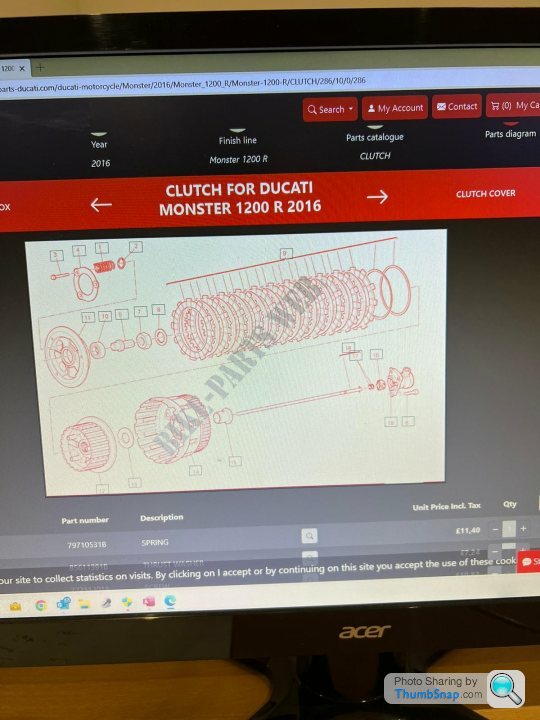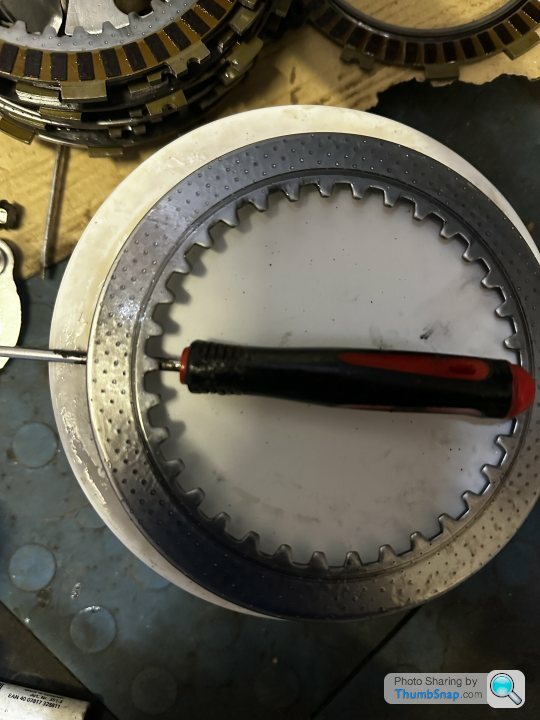Ducati Monster 1200r clutch query
Discussion
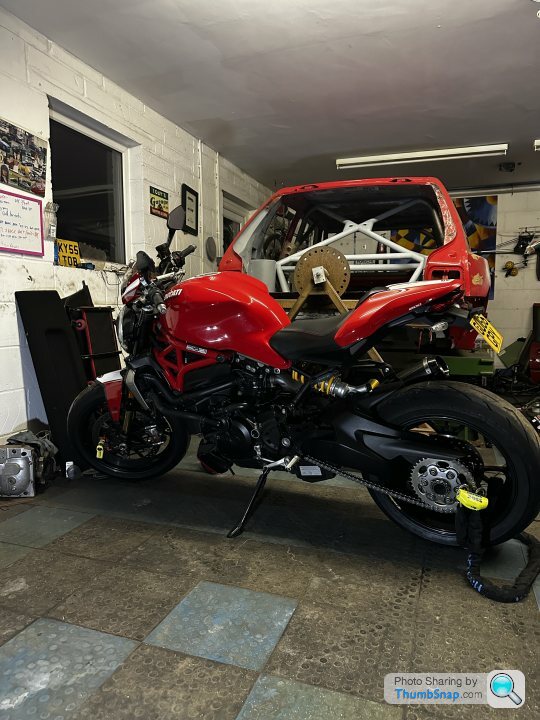
Hi All, I have my fiends 2017 Ducati Monster 1200 here. It has an odd clutch issue.
It has done 17000 miles from new on the current clutch.
I found a leak in the slave cylinder so replaced the slave with an oem slave. Put new fluid in and bled it all up. I also put new o rings on the shaft that goes through the gearbox and made sure the anti rotation pin is seated.
The bike will start and you have a perfect clutch lever, lovely biting point.
Then, for the next 4 pulls you get less and less biting point (closer and closer to the bar). Until the clutch no longer works and the bike just moves forward regardless of the clutch.
If you turn off the bike and then restart it you get a perfect clutch again and the next 4 pulls do the same thing.
Therefore the master and slave seem perfect
The Ducati shop say that when the clutches wear out they normally just slip, not the other way around.
My friend is happy to put a new clutch in it but he doesn’t want to just chuck money at it if the plates are ok.
Any thoughts? Or anyone who might know?
Ducati Alton said they have not heard of this before. It’s a 1200r but I think all the monsters are the same.
My experience is from older Ducati clutches.
I used to commute on these things and I've done more miles on Ducs in stop-start traffic than anyone should!
The old dry clutches used to generate a lot of forum traffic and opinion.
I will offer two, make that three!, possibilities based on experience, mine and other peoples!
1) the push rod which goes through the gear shaft is bent, corroded or jamming for some other reason
2) the big nut has come loose and the basket is on the move
3) warped plates
Other than that, I'd check fundamentals, like the cover plate lifting evenly.
A warped plate heats more than the others and warps more. I check them on a glass surface plate.
The nut coming loose, not sure exactly how that does what you describe, but it's what happened.
The pushrod thing, mysterious exactly how it stops the slave cylinder working right, but on the old bikes they catch crap from the sprocket and they also get bent when they jam in the pressure plate bearing and get pulled out that way when stripping the clutch.
The absolute essence of a happy Ducati clutch is flat, unwarped plates. You can get away with worn plates, damage where plate meets basket or hub, but not warped plates.
I used to commute on these things and I've done more miles on Ducs in stop-start traffic than anyone should!
The old dry clutches used to generate a lot of forum traffic and opinion.
I will offer two, make that three!, possibilities based on experience, mine and other peoples!
1) the push rod which goes through the gear shaft is bent, corroded or jamming for some other reason
2) the big nut has come loose and the basket is on the move
3) warped plates
Other than that, I'd check fundamentals, like the cover plate lifting evenly.
A warped plate heats more than the others and warps more. I check them on a glass surface plate.
The nut coming loose, not sure exactly how that does what you describe, but it's what happened.
The pushrod thing, mysterious exactly how it stops the slave cylinder working right, but on the old bikes they catch crap from the sprocket and they also get bent when they jam in the pressure plate bearing and get pulled out that way when stripping the clutch.
The absolute essence of a happy Ducati clutch is flat, unwarped plates. You can get away with worn plates, damage where plate meets basket or hub, but not warped plates.
Thanks for the reply, the push rod moves pretty freely, it does have some black deposits on it but assume this is from the oil. It is a wet clutch.
I am guessing the next step may be to remove the clutch cover and inspect the plates and check the nut.
It seems odd that to re start the bike brings back the clutch and you can repeat the failure every time over 5 pulls.
I am guessing the next step may be to remove the clutch cover and inspect the plates and check the nut.
It seems odd that to re start the bike brings back the clutch and you can repeat the failure every time over 5 pulls.
As said previously, check for warped plates and centre nut security....
If they both check out, measure the total clutch pack thickness against the factory specification.
It's likely that you have a combination of issues unrelated to each other but both affecting the clutch.
Also, check the integrity of the clutch hydraulic system. It may be leaking past a seal and losing the pressure to the slave cylinder.
Final check, as it's a wet clutch, is the correct oil being used and not car specification oil..... wouldn't be the first time
If they both check out, measure the total clutch pack thickness against the factory specification.
It's likely that you have a combination of issues unrelated to each other but both affecting the clutch.
Also, check the integrity of the clutch hydraulic system. It may be leaking past a seal and losing the pressure to the slave cylinder.
Final check, as it's a wet clutch, is the correct oil being used and not car specification oil..... wouldn't be the first time

I had an issue with my S1000R in that the clutch adjustment would fall out within minutes of riding the bike.
I knew it wasnt the plates but in the mechanisim somewhere.
My issue turned out to be a bearing failing in the output shaft, leaving the clutch basket to move about, so I would say “Out in the sheds” idea of the centre nut coming loose would be a good first point of call.
I knew it wasnt the plates but in the mechanisim somewhere.
My issue turned out to be a bearing failing in the output shaft, leaving the clutch basket to move about, so I would say “Out in the sheds” idea of the centre nut coming loose would be a good first point of call.
Caddyshack said:
Thanks for the reply, the push rod moves pretty freely, it does have some black deposits on it but assume this is from the oil. It is a wet clutch.
I am guessing the next step may be to remove the clutch cover and inspect the plates and check the nut.
It seems odd that to re start the bike brings back the clutch and you can repeat the failure every time over 5 pulls.
I can't claim to be totally sure how the failure of the clutch nut came to mainfiest itself the way it did.I am guessing the next step may be to remove the clutch cover and inspect the plates and check the nut.
It seems odd that to re start the bike brings back the clutch and you can repeat the failure every time over 5 pulls.
More time was spent debating it than fixing it!
If there is a special lockwasher under that nut, use a brand new one!
Nut seems very tight.
When I operate the clutch there is a bit of movement in the cover and if you look at the pic below you can see some witness marked where the cover or the springs have touched. I am thinking that part 5 from the exploded diagram in the thread above may have worn and is allowing some play and this is allowing the cover to touch the clutch basket?
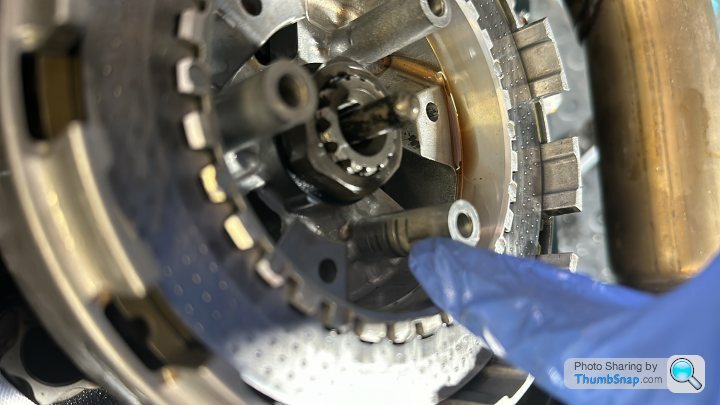
The bearing seems good but I guess it could have some movement, it will be worth replacing the bearing anyway, I assume it will have to be pressed out and therefore the new one pressed in unless I do the oven and freezer trick for the new bearing.
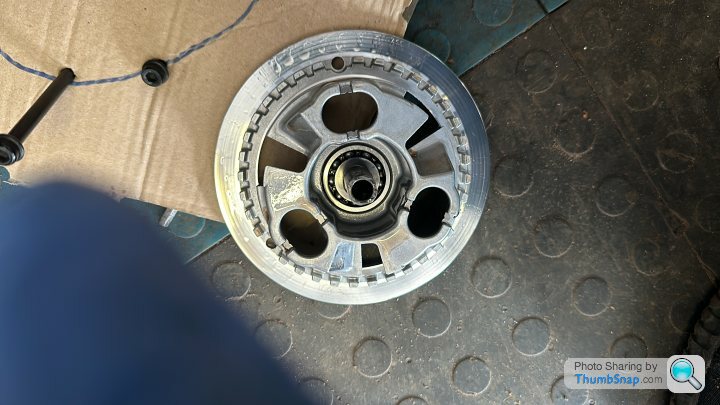
With the clutch lever all the way in you can wiggle the clutch cover which makes me think this may be happening when the engine is running and binding on the basket.
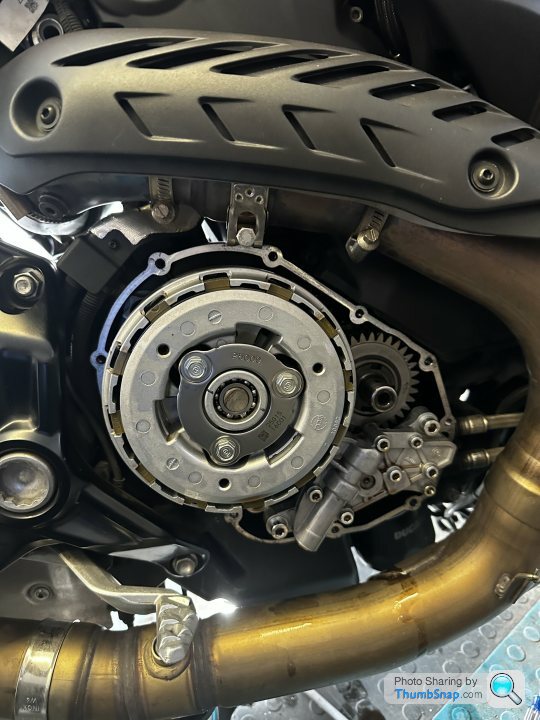
When I operate the clutch there is a bit of movement in the cover and if you look at the pic below you can see some witness marked where the cover or the springs have touched. I am thinking that part 5 from the exploded diagram in the thread above may have worn and is allowing some play and this is allowing the cover to touch the clutch basket?

The bearing seems good but I guess it could have some movement, it will be worth replacing the bearing anyway, I assume it will have to be pressed out and therefore the new one pressed in unless I do the oven and freezer trick for the new bearing.

With the clutch lever all the way in you can wiggle the clutch cover which makes me think this may be happening when the engine is running and binding on the basket.

When the clutch is pulled in, the cover plate should be able to rotate a degree or two relative to the hub, it locates on the same splines as the plain plates?
I don't understand those 'witness marks'?
They are on just one of the three 'posts' inside one of the springs? The spring should not be rubbing on the post, it should be seated at either end.
The cover plate should not be rattling about enough on the hub to make the spring rub on the post.
On the old dry clutches, the cover plate only goes one way on the centre hub, there is no 'rotational symmetry', you can't turn it around by one spring IYSWIM? There is a mark to say this spring post goes in this hole. I don't see any such marks on you clutch, but.....
If only one spring is rubbing on a post does that suggest it was put together wrong?
Or a spring has failed?
I would check all the springs are the same, correct length.
When you pump the lever, the cover plate item 11 must move across the bike, the spring retaining plate item 4 (my made up name for it!), must not.
I might use a dial gauge to check it's compressing all three springs equally.
When the clutch drags/binds when the bike is running, I assume the pressure on it feels normal? ('normal' for a Ducati)
I don't understand those 'witness marks'?
They are on just one of the three 'posts' inside one of the springs? The spring should not be rubbing on the post, it should be seated at either end.
The cover plate should not be rattling about enough on the hub to make the spring rub on the post.
On the old dry clutches, the cover plate only goes one way on the centre hub, there is no 'rotational symmetry', you can't turn it around by one spring IYSWIM? There is a mark to say this spring post goes in this hole. I don't see any such marks on you clutch, but.....
If only one spring is rubbing on a post does that suggest it was put together wrong?
Or a spring has failed?
I would check all the springs are the same, correct length.
When you pump the lever, the cover plate item 11 must move across the bike, the spring retaining plate item 4 (my made up name for it!), must not.
I might use a dial gauge to check it's compressing all three springs equally.
When the clutch drags/binds when the bike is running, I assume the pressure on it feels normal? ('normal' for a Ducati)
Thanks for looking.
The spring witness marks are mainly on that one tube but each of the others has one mark on it.
When the clutch is used it feels normal, you just get less and less clutch each time when the bike is running (biting point gets closer to the bars with each use until you get none over 4-5 uses) with the engine off the clutch moves across the same amount each and every time and holds, I cannot get the clutch to replicate the issue with the clutch cover off obviously no engine running)
There is movement on what you call the spring retention plate (number 11) when the clutch lever is all the way in, some rotational and a fair bit of play like a wobbly plate spinning on a pole, not huge but you can move it about with you hand.
I will measure the springs and may just replace them at £10 each although trying not to spend my friends money right now.
Part number 5 slips inside the basket and the push rod comes up through that, part 5 looks quite polished to me and I am wondering if that is allowing the spring plate to wander about and thus the marks, if the number 11 leans to one side I am thinking that it may be binding against 14 and maybe squeezing some of the clutch plates together enough to drag the bike along.
I can put a dial gauge on it and measure any run out and just how much the spring retention plate can move.
The clutch cover have never been off and this is the original clutch from new, my friend bought the bike brand new and has never had the clutch apart.
I still cannot fathom why turning the bike off, let it sit for 1-2 mins and then start again brings the clutch back for another few goes, if it didn’t do that I would suspect the hyrdraulics were allowing fluid back - maybe via a leaky master (ruled out the slave as replaced that with the exact same outcome)
I appreciate all the responses, it’s good to have a sounding board. The parts guy is very helpful at Ducati Alton as the two brothers have bought a lot of bikes there and had them serviced there, I will show the technicians the pics and a video of the movement.
The spring witness marks are mainly on that one tube but each of the others has one mark on it.
When the clutch is used it feels normal, you just get less and less clutch each time when the bike is running (biting point gets closer to the bars with each use until you get none over 4-5 uses) with the engine off the clutch moves across the same amount each and every time and holds, I cannot get the clutch to replicate the issue with the clutch cover off obviously no engine running)
There is movement on what you call the spring retention plate (number 11) when the clutch lever is all the way in, some rotational and a fair bit of play like a wobbly plate spinning on a pole, not huge but you can move it about with you hand.
I will measure the springs and may just replace them at £10 each although trying not to spend my friends money right now.
Part number 5 slips inside the basket and the push rod comes up through that, part 5 looks quite polished to me and I am wondering if that is allowing the spring plate to wander about and thus the marks, if the number 11 leans to one side I am thinking that it may be binding against 14 and maybe squeezing some of the clutch plates together enough to drag the bike along.
I can put a dial gauge on it and measure any run out and just how much the spring retention plate can move.
The clutch cover have never been off and this is the original clutch from new, my friend bought the bike brand new and has never had the clutch apart.
I still cannot fathom why turning the bike off, let it sit for 1-2 mins and then start again brings the clutch back for another few goes, if it didn’t do that I would suspect the hyrdraulics were allowing fluid back - maybe via a leaky master (ruled out the slave as replaced that with the exact same outcome)
I appreciate all the responses, it’s good to have a sounding board. The parts guy is very helpful at Ducati Alton as the two brothers have bought a lot of bikes there and had them serviced there, I will show the technicians the pics and a video of the movement.
Part 5 is the thing which sits between the pushrod and the bearing.
If that is worn, I wonder if the bearing is failing?
Bearings are cheap.
I would re-iterate the importance of flat, not warped, plates.
You may have checked that, but I can't see up the thread now I've started replying.
Good Luck!
If that is worn, I wonder if the bearing is failing?
Bearings are cheap.
I would re-iterate the importance of flat, not warped, plates.
You may have checked that, but I can't see up the thread now I've started replying.
Good Luck!
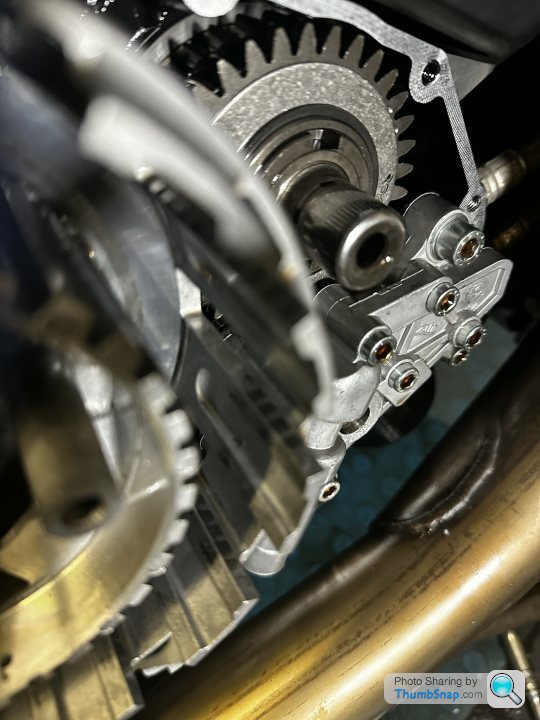
I took out the clutch plates and they all sit dead level on a piece of glass.
My friend who used to race motocross thought that maybe the clutch plates could sticking on the egde of the clutch basket. I can run a finger nail down them and feel tiny ridges and you can see where the plates have rubbed a little but not sure if this is an issue?
I would like to try and find out the total throw of the clutch plate from clutch in to out to check the master cylinder is moving the rod enough.
I've seen clutch baskets look much more ragged than that and still work sweetly.
Is that last steel plate dished? There's a dished plate in the dry clutches, supposedly makes the clutch 'progressive' rather than on/off.
People used to bang on about the 'stack height' of all the plates together. personally I never had a problem related to this. People reported sorting errant clutches by adding an extra plate to make the stack height 'in limits'. I've no reason to disbelieve them, but not my personal experience.
I'm getting short of ideas, other than loose bearings etc which allow the hub to not be on the same axis as the basket. I had a 1961 BSA like this, always engage neutral while you're still doing 10mph or you are doomed.
Is that last steel plate dished? There's a dished plate in the dry clutches, supposedly makes the clutch 'progressive' rather than on/off.
People used to bang on about the 'stack height' of all the plates together. personally I never had a problem related to this. People reported sorting errant clutches by adding an extra plate to make the stack height 'in limits'. I've no reason to disbelieve them, but not my personal experience.
I'm getting short of ideas, other than loose bearings etc which allow the hub to not be on the same axis as the basket. I had a 1961 BSA like this, always engage neutral while you're still doing 10mph or you are doomed.
Thanks, I was hoping to have found something a lot more obvious.
The last plate isn’t dished but it has a Belleville domed washer behind to do the same job, I guess.
I think I will rebuild the master cylinder to rule out the hydraulics 100% and then replace the bearing and re assemble and see if the problem repeats before changing anything else.
The last plate isn’t dished but it has a Belleville domed washer behind to do the same job, I guess.
I think I will rebuild the master cylinder to rule out the hydraulics 100% and then replace the bearing and re assemble and see if the problem repeats before changing anything else.
Thanks, I was hoping to have found something a lot more obvious.
The last plate isn’t dished but it has a Belleville domed washer behind to do the same job, I guess.
I think I will rebuild the master cylinder to rule out the hydraulics 100% and then replace the bearing and re assemble and see if the problem repeats before changing anything else.
The last plate isn’t dished but it has a Belleville domed washer behind to do the same job, I guess.
I think I will rebuild the master cylinder to rule out the hydraulics 100% and then replace the bearing and re assemble and see if the problem repeats before changing anything else.
Gassing Station | Biker Banter | Top of Page | What's New | My Stuff




